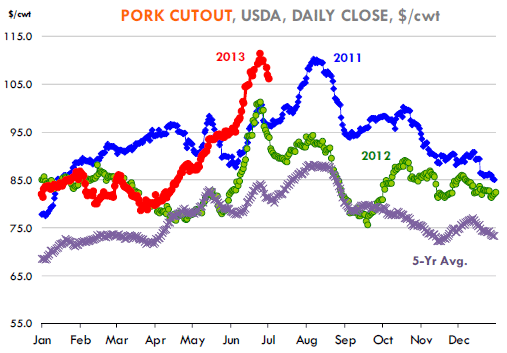



CME: Hog Market Futures Increasingly Jittery
US - Hog futures market has become increasingly jittery as the pork cutout has declined some $5/cwt. from its peak on 25 June, write Steve Meyer and Len Steiner.While futures were for the most part up on Wednesday, on a short trading session, market participants worry that pork prices may have already set the highs for the year and could drop sharply in the coming weeks In 2012, prices rose just sharply into the 4 July weekend only to drop some 11 per cent in the first two weeks of July. Generally this time a year is a battle between weakening demand, as summer heat takes its toll on outdoor grilling, and tighter supplies.
The decline in supplies comes not just because of fewer hogs coming to market but also due to much lighter hog carcass weights. Hog carcass weights have declined about two per cent since late April and they are expected to decline another two per cent in the next few weeks. It would seem from the price chart below that smaller supplies trump the decline in demand.

The five year average price chart shows that normally cutout values remain firm all the way into August. Keep in mind, however, that the data in part is skewed by what happened in 2011 and 2008. In both those years we saw a rush of export orders to China. There is some speculation that the recent tentative sale of Smithfield, the largest US pork packer, to a Chinese company already has translated to a surge in shipments to that market.
The export data is reported with a significant lag and the weekly pork export numbers are still incomplete to verify those claims. It is possible, however, that Smithfield orders to China may have increased since they now have the biggest supply of ractopamine-free hogs. However, this is not the same as saying that the US as a whole is shipping more pork to China. The data for May shows that US pork exports to China have improved compared to earlier in the year. May pork exports to China were 16,510 MT, about 6500 MT or 65 per cent higher than in Q1 of this year but still some 14 per cent lower than a year ago. We will have a more complete review of pork export data in the next issue of DLR.
We would argue that demand and pricing of pork bellies remains a key factor for hog prices in Q3 and Q4. The chart to the right shows the seasonal tendency for pork belly prices during the year. We have overlaid to this the price performance for pork bellies so far this year. The belly price has increased steadily since April. In part this is seasonal but also there is increasing evidence that some foodservice promotions stoked demand for this product in Q2.

As we have noted in the past, anywhere between 80-90 per cent of the year over year increase in the pork cutout since April has been due to the surge in the price of bellies. On Wednesday, USDA quoted the pork belly cutout at $166.43/ cwt, 25 per cent higher than the same period a year ago but about 11 per cent lower than what it was last week. Since last week, the pork cutout has declined about $5.3/cwt. and two thirds of that decline is due to lower belly prices.
The worry is that if/when belly prices head south in late July, it could significantly pressure pork and hog prices. Better export demand clearly would tend to offset some of this decline, as was the case in 2011. The latest Hogs and Pigs report also indicated that hog slaughter in Q3 could end up being lower than in 2012. One item to watch are hams, an item that should start to carry the cutout once the seasonal belly demand wanes. Hog values in the mid 80s without strong ham prices will be difficult to sustain.








